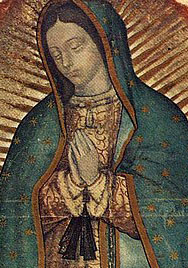Saint of the Day Online - Our Lady of Guadalupe
Saint of the day online, Tuesday, December 12, 2017
12-12-2017
Saint Name: Our Lady of Guadalupe
Place: Mexico City
Birth: 1531
Feast: December 06
Our Lady of Guadalupe also known as the Virgin of Guadalupe is a Roman Catholic title of the Blessed Virgin Mary associated with a venerated image enshrined within the Minor Basilica of Our Lady of Guadalupe in Mexico City.
Juan Diego is 57 years old. He has just encountered the Virgin Mary on Tepeyac Hill, the site of a former Aztec Temple. His wife has died two years earlier, and he lives with his elder uncle, scratching his living from the earth as a humble peasant farmer. Why should this unlearned, man be chosen by Our Lady to carry a message to the Bishop? Perhaps because she would find none other as humble as Juan Diego.
Juan Diego is dazzled by the incredible beauty and miraculous nature of Our Lady's appearance. She appears as a native princess to him, and her words sound more beautiful than the sweetest music ever made.
Our Lady calms the startled traveler, and assures him of who she is. She instructs Juan Diego to visit his bishop and ask that a temple be built on the site of her appearance, so that she will have a place to hear petitions and to heal the suffering of the Mexican people. "Now go and put forth your best effort," Our Lady instructs.
Visibly shaken, Juan Diego approaches the Bishop who is initially very skeptical of his account. What did this peasant truly want? Does he merely seek attention? Notoriety? Money? Or is he possessed by demons? Has Juan Diego been tricked by the Devil?
The Bishop patiently listens to Juan Diego's accounts and dismisses him. The humble farmer has failed.
Juan Diego begins to doubt himself. He returns to Tepeyac Hill where he hopes for some conformation of what he's experienced. Indeed, Our Lady does not disappoint, for she appears again, as radiant as before. Juan Diego tells Our Lady what she already knows, that the Bishop did not believe him. She instructs him to return the next morning and ask again.
Juan Diego's tilma has become Mexico's most popular religious and cultural symbol, and has received widespread ecclesiastical and popular support. In the 19th century it became the rallying call of American-born Spaniards in New Spain, who saw the story of the apparition as legitimizing their own Mexican origin and infusing it with an almost messianic sense of mission and identity – thus also legitimizing their armed rebellion against Spain.
Historically the devotion to Our Lady of Guadalupe did not lack clerical opponents within Mexico, especially in the early years, and in more recent times some Catholic scholars, and even a former abbot of the basilica, Monsignor Guillermo Schulenburg, have openly doubted the historical existence of Juan Diego, referring to the devotion as merely symbolic, propagated by a sensational cult. Nonetheless, Juan Diego was canonized in 2002, under the name Saint Juan Diego Cuauhtlatoatzin.
While the image garners much religious devotion and Mexican patriotism, scholarly criticism on the image is also notable, considering the artistic disproportion of the image, the similarity of the image to Spanish pre-colonial artwork closely related to the Aztec colony at the time, the alleged relationship of Marcos Cipac de Aquino in either inventing or amending the tilma cloak, and the public declaration of the abbot of the Guadalupe shrine pertaining to the false existence of the Marian apparitions.
On October 12, 1945, Pope Pius XII, decreed Our Lady of Guadalupe to be "Patroness of all the Americas." Her feast day is December 12, and it is a Holy Day of Obligation in Mexico.